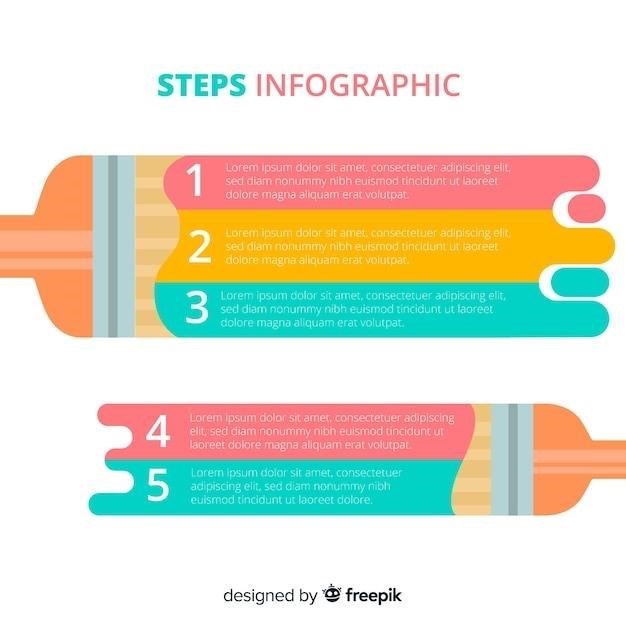amp research power step instructions

AMP Research PowerStep Installation⁚ A Comprehensive Guide
This guide provides a detailed walkthrough for installing AMP Research PowerSteps. It covers tool preparation‚ wiring‚ motor installation‚ controller placement‚ step mounting‚ and final testing. Safety precautions and troubleshooting tips are included for a successful installation. Consult the specific instructions for your vehicle model.
Tools and Preparation
Before beginning the AMP Research PowerStep installation‚ gather the necessary tools and materials. This typically includes a socket set (metric)‚ various wrenches (including an Allen wrench)‚ a Phillips head screwdriver‚ a flathead screwdriver‚ safety glasses‚ measuring tape‚ cable ties‚ and possibly a drill with appropriate bits depending on your vehicle’s specifications. Ensure you have the AMP Research PowerStep kit appropriate for your vehicle model and year‚ including all mounting hardware‚ wiring harnesses‚ and controllers. Review the specific instructions accompanying your kit as tool requirements may vary slightly. Clear a well-lit workspace with adequate room to maneuver around your vehicle. Consult your vehicle’s owner’s manual for any vehicle-specific instructions or precautions. Disconnect the vehicle’s negative battery terminal to prevent accidental electrical shorts during the wiring process. This critical safety step helps avoid potential damage to your vehicle’s electrical system. Having all components readily accessible will streamline the installation process.
Step-by-Step Wiring Instructions⁚ Power and Ground Connections
Precise wiring is crucial for proper PowerStep functionality. Begin by securely connecting the positive (+) power wire from the battery to the designated terminal on the PowerStep control module. Use a properly sized fuse inline with the positive wire‚ as specified in your installation manual‚ to protect the system from overcurrent. Next‚ connect the negative (-) ground wire to a clean‚ unpainted metal surface on the vehicle’s chassis‚ ensuring a solid connection to prevent voltage drops. The provided instructions will detail specific locations for optimal grounding. Carefully follow the wiring diagram included in your kit; it shows how to connect the power and ground wires to the appropriate components of the system. Incorrect connections can lead to malfunction or damage. Use crimp connectors or other suitable methods for secure and corrosion-resistant connections. After making all connections‚ double-check all wiring to ensure everything is securely fastened and correctly routed to avoid interference with moving parts. Avoid pinching or kinking wires during routing‚ and secure any loose wires with cable ties.
Motor Installation and Linkage Assembly
Precisely mounting the motors and assembling the linkages is key to smooth PowerStep operation. Begin by carefully attaching the motors to the linkage assemblies‚ ensuring proper alignment as shown in the diagram. Use the provided hardware and torque specifications to secure each connection; avoid over-tightening‚ which can strip threads or damage components. The linkages should move freely without binding or resistance. Pay close attention to the orientation of the motors to ensure they actuate correctly; reversing the motor orientation will result in incorrect step deployment. Once the motors are securely attached‚ carefully connect the linkage arms to the step assemblies. Ensure that the linkages are properly aligned and that all pins and bolts are correctly installed and tightened to the specified torque. Test the range of motion for the linkages‚ ensuring they move smoothly and freely throughout their full operational range. Any binding or resistance indicates a misalignment or incorrectly installed component. Before proceeding‚ double-check that all connections are secure and that the steps move freely‚ extending and retracting smoothly without any interference.
Controller Placement and Wiring
Careful placement and secure wiring of the control module are crucial for reliable PowerStep function. Refer to your vehicle’s specific instructions for the optimal controller location; common spots include near the battery or firewall. Ensure the chosen location provides sufficient ventilation to prevent overheating. Securely mount the controller using the supplied hardware‚ avoiding any potential pinch points or areas of excessive vibration. Next‚ connect the wiring harness to the controller‚ paying close attention to color-coded connections; incorrect wiring can lead to malfunctions or damage. Double-check all connections for proper seating and secure fastening; loose connections can cause intermittent operation or complete failure. Route the wiring harness neatly and securely‚ avoiding sharp bends or contact with moving parts. Use cable ties to manage excess wire length and prevent the harness from obstructing other components. Once the wiring is complete‚ check for any exposed wires or loose connections. Before powering on the system‚ visually inspect all connections to ensure they are correctly installed and secure. This careful attention to detail will ensure years of reliable operation from your AMP Research PowerSteps.
Step Extrusion Mounting and Adjustment
Precise mounting of the step extrusion is essential for proper function and aesthetics. Begin by aligning the extrusion with the vehicle’s mounting points‚ ensuring it is level and parallel to the ground. Use the provided hardware to loosely attach the extrusion‚ allowing for minor adjustments. Carefully check alignment from multiple angles to ensure the step is properly positioned relative to the vehicle’s body and any other components. Once the alignment is satisfactory‚ tighten the fasteners to the specified torque‚ using the correct tools to prevent damage. Pay close attention to the instructions specific to your vehicle model‚ as mounting points and procedures may vary; After tightening‚ test the step’s deployment and retraction; it should move smoothly and without binding. If any binding occurs‚ carefully loosen the fasteners‚ make minor adjustments to the extrusion’s position‚ and re-tighten. This process might require several iterations to achieve optimal alignment and smooth operation. Remember to check the alignment and movement of the step after each adjustment. Proper mounting ensures safe and reliable operation of your AMP Research PowerSteps.

Securing the PowerStep⁚ Bolt Tightening and Torque Specifications
The final step in the mechanical installation is securing the PowerStep using the provided bolts and hardware. Accurate torque is crucial to prevent damage and ensure reliable performance. Refer to the provided torque specifications for your specific PowerStep model and vehicle application; these values are critical for safe and long-lasting operation. Use a torque wrench to achieve the correct tightness; avoid over-tightening‚ which can strip the threads or damage the mounting points. Before tightening‚ ensure all components are correctly aligned and positioned according to the installation guide. Double-check that all hardware is present and accounted for before beginning the tightening process. After tightening‚ visually inspect the installation‚ ensuring the PowerStep is securely mounted and all bolts are flush against the mounting surfaces. Any loose or improperly tightened bolts can compromise the structural integrity and lead to potential malfunctions or safety hazards. Take your time during this step to ensure a secure and reliable installation that will withstand the rigors of daily use.
Testing and Calibration
After completing the PowerStep installation‚ thorough testing is essential to verify proper functionality and address any potential issues. Begin by cycling the power steps multiple times‚ observing their smooth extension and retraction. Listen for any unusual noises or binding during operation; these could indicate misalignment or interference. Check for consistent deployment and retraction speed; uneven movement may suggest a problem with the motor‚ linkage‚ or wiring. Inspect the LED lights (if equipped) to ensure they illuminate correctly upon deployment and turn off upon retraction. If the PowerSteps fail to deploy or retract smoothly‚ carefully review the installation steps‚ checking for any loose connections or improperly routed wiring. Consult the troubleshooting section of the installation manual for guidance on resolving common issues. If problems persist despite troubleshooting‚ contact AMP Research technical support for assistance. Proper calibration might be needed depending on your specific model; refer to the manual for instructions on adjusting the steps’ deployment and retraction limits for optimal performance and to prevent interference with other vehicle components. A well-tested and properly calibrated system ensures safe and reliable operation.
Troubleshooting Common Installation Issues
During AMP Research PowerStep installation‚ several issues might arise. If the steps fail to deploy or retract‚ first check the power connections. Ensure the battery is providing sufficient voltage and that all wires are securely connected to the controller and motor. Loose or improperly crimped connections are frequent culprits. Examine the wiring harness for any pinched or damaged wires‚ paying close attention to areas where the harness might be close to moving parts. Next‚ verify the motor’s proper installation and function. A malfunctioning motor can be identified by unusual sounds or a lack of movement. Verify the linkage assembly is correctly attached and free from obstructions. Binding or resistance in the linkage mechanism can prevent smooth operation. Incorrectly adjusted limit switches can cause premature stopping or incomplete deployment. Refer to the installation manual for precise adjustment procedures. If the LED lights don’t function‚ check the light connections and the controller settings. Finally‚ if the steps deploy unevenly or bind‚ ensure proper alignment of the step extrusion with the vehicle body. Recheck all mounting bolts and torque specifications. If issues persist despite these checks‚ consult AMP Research’s technical support or a qualified automotive installer.
Safety Precautions During Installation
Prioritize safety throughout the AMP Research PowerStep installation. Always disconnect the vehicle’s negative battery terminal before commencing any electrical work. This prevents accidental short circuits and potential injury. Wear appropriate safety glasses or goggles to protect your eyes from flying debris or sparks during drilling or fastening. Use caution when working with sharp tools such as drills‚ screwdrivers‚ and wrenches. Ensure proper ventilation when working in confined spaces under the vehicle to avoid inhaling harmful fumes or exhaust gases. Never work under a vehicle supported only by a jack; use jack stands for secure support. If you’re unfamiliar with automotive electrical systems or mechanical procedures‚ consult a professional installer. Improper installation can lead to malfunction‚ damage to your vehicle‚ and potentially hazardous situations. Use only the tools and hardware specified in the AMP Research installation manual. Improper tools or hardware could lead to damage or injury. Always refer to your vehicle’s owner’s manual for any specific safety guidelines or warnings related to working on your vehicle. Remember‚ safety is paramount; if you are ever unsure about a step in the process‚ stop and seek professional assistance.
Post-Installation Care and Maintenance

Regular maintenance ensures the longevity and optimal performance of your AMP Research PowerSteps. Periodically inspect all mounting hardware for tightness‚ addressing any loose bolts or fasteners promptly. Clean the PowerSteps regularly using mild soap and water‚ avoiding harsh chemicals or abrasive cleaners that could damage the finish. Pay close attention to the moving parts of the steps‚ lubricating any hinges or linkages as needed with a silicone-based lubricant. This will ensure smooth operation and prevent squeaking or binding. Inspect the wiring harness for any signs of damage‚ chafing‚ or loose connections. Repair or replace any damaged wiring immediately to prevent electrical issues. Avoid overloading the PowerSteps; exceeding the weight capacity could lead to damage or malfunction. During winter months‚ clear snow and ice from the steps before use. If you notice any unusual noises‚ binding‚ or malfunction‚ consult the troubleshooting section of the AMP Research installation manual or contact their customer support for assistance. Following these simple maintenance steps will help maintain the functionality and aesthetics of your PowerSteps for years to come‚ ensuring a safe and reliable experience every time you use them. Proactive maintenance is key to preventing more significant problems down the road.
Leave a Reply
You must be logged in to post a comment.